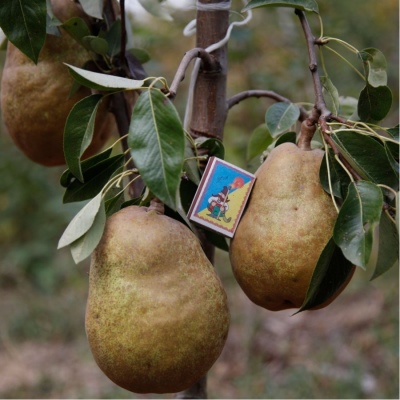
- Authors: J. Delbar (France)
- Name synonyms: Snowball, Snowflake pear, Ricks pear, Delbarayu
- Fruit weight, g: 250 - 320, on a quince rootstock 300 - 500
- Ripening terms: autumn-winter
- Fruit picking time: early October
- Appointment: fresh
- Growth type: vigorous and medium-sized
- Transportability: high
- Fruit shape: elongated, pear-shaped
- Coloring of the fruit during the period of removable maturity: green
Many summer residents prefer to grow pear trees, which give large and tasty fruits. These include the autumn-winter French-bred Delbariu variety, which perfectly adapts to different climatic conditions.
Breeding history
Pear Delbarue was bred by the French breeder J. Delbar, whose main task was to create a large-fruited variety with simple agricultural technology and sufficient stress resistance. The pear has several names - Snowflake, Delbarao, Ricks, Snowflake. The pear is recommended for cultivation in the central and southern regions, but in cooler zones the tree is also planted.
Description of the variety
The French pear is a medium-sized tree that some scientists consider to be large. On average, the tree grows up to 3.5 meters. The tree looks powerful, while compactly located in the garden. The pear is characterized by moderate thickening of green leaves, a strong skeleton consisting of brown-brown branches, and a regular crown shape. The fruits are tied on ringlets. During the flowering period, the tree becomes very beautiful, covered with large snow-white flowers that smell good.
Fruit characteristics
Delbarju is a bright representative of large-fruited varieties. Under favorable conditions, the fruit gains a mass of 250-320 grams, but in some cases the fruits gain weight up to 500 g. The shape of the pear is correct - elongated pear-shaped with a slightly rough surface. At the stage of removable maturity, the pear has a green color, which by the time of consumer ripeness changes to dark yellow. Often, on the sunny side of the pear, a blurry pink blush appears. The peel of the fruit is rather dense, but not hard, with pronounced subcutaneous punctures of dark brown color.
The advantage of the variety is excellent transportability and long shelf life - about 3 months. In order for pears to lie for a long time without losing their taste and marketability, they must be removed at the stage of technical maturity. Overripe fruits are stored less.
Taste qualities
Excellent taste is one of the advantages of this variety. White pear pulp is characterized by a delicate, fleshy, fine-grained and buttery structure with high juiciness. The taste of the fruit is balanced - sweetish with a barely noticeable piquant sourness, complemented by a light, pleasant aroma.
Ripening and fruiting
Pear belongs to the class of autumn-winter varieties. The culture begins to bear fruit in the 2-4th year after planting. Fruiting at the tree is stable and generous. The active phase of fruiting occurs in the first half of October, and consumer maturity at the end of the month.

Yield
The yield indicators of the variety are high. Subject to agrotechnical recommendations, up to 30-35 kg of juicy pears can be removed from one tree per season.
Self-fertility and the need for pollinators
The pear does not need donor trees, since it is self-fertile, however, other species planted nearby will not negatively affect the yield of this fruit crop at all.
Landing
You can plant seedlings in the spring, when the soil and air are warm enough, as well as in the fall - 3-4 weeks before frost, since the root system needs to get stronger and adapt. For planting, it is recommended to purchase one / two-year-old seedlings. The optimal landing pattern is 3.5x3.5 or 4x4 meters.


Growing and care
The Delbarju pear variety is not capricious in terms of care, but picky about the planting site and soil. It is recommended to plant a pear in a fertile, air- and moisture-permeable soil. It is better to choose a site on a small hill with a deep passage of groundwater, since the root system does not like moisture stagnation. An area well-lit by the sun's rays and protected from gusty winds or drafts is suitable for the tree.
Comprehensive care of a fruit tree includes: regular watering, weeding and loosening of the peri-stem circle, application of fertilizing (organic matter, superphosphates, urea, wood ash), installation of backwaters, since the fruits are weighty, which can lead to breakage of branches, protection from viruses, insects and rodents ... In addition, do not forget about sanitary pruning of branches, crown formation, whitewashing of trunks, warming of rhizomes for the winter in regions with cold winters.



Disease and pest resistance
The variety has a high immune system. The tree is absolutely resistant to powdery mildew and scab, and is also rarely exposed to other viruses and fungal diseases. It is possible to protect the pear from the invasion of pests by carrying out timely preventive treatments with special preparations.

Like any other fruit trees, the pear needs protection from various diseases and pests. When planting a pear on your site, you need to know in advance what diseases you should beware of. To successfully carry out the struggle, it is necessary first to correctly identify the cause of the problem.It is important to distinguish signs of disease from manifestations of the presence of insects, mites, caterpillars and other types of pests.
Resistance to soil and climatic conditions
Due to its strong resistance to stress, the pear easily tolerates many natural phenomena - sharp temperature jumps, short shade, drought and heat. In addition, the tree is frost-resistant.





































































